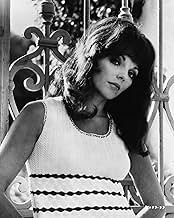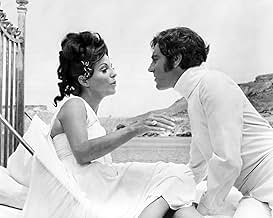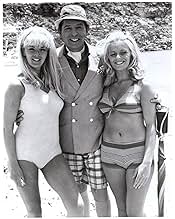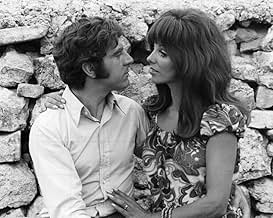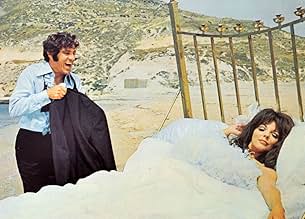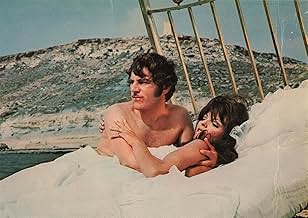Le carrousel fantastique
Titre original : Can Heironymus Merkin Ever Forget Mercy Humppe and Find True Happiness?
NOTE IMDb
4,9/10
433
MA NOTE
Ajouter une intrigue dans votre langueHeironymus Merkin screens an autobiographical movie of his life, growth, and moral decay.Heironymus Merkin screens an autobiographical movie of his life, growth, and moral decay.Heironymus Merkin screens an autobiographical movie of his life, growth, and moral decay.
- Réalisation
- Scénario
- Casting principal
- Récompenses
- 1 victoire au total
Tara Newley Arkle
- Thumbelina
- (as Tara Newley)
Avis à la une
With a long title and confusing plot, "Can Hieronymus Merkin Ever Forget Mercy Humppe and Find True Happiness?" left me befuddled. Portraying an entertainer (Anthony Newley) recounting his life story as a series of short films, the whole movie feels like something drifting aimlessly in water. It seems like a giant ego project. I'm still trying to figure out what the movie's overall point was.
Since I found this on what appeared to be a pirated video, I suspect that no one saw fit to formally release this movie on video (or DVD). Like one of Newley's later, equally confusing movies ("It Seemed Like a Good Idea at the Time", notable for an early appearance of John Candy), it's not terrible but seems to have no point whatsoever. You probably don't want to make it your first choice. I have to admit that I'd never heard of Anthony Newley until he died.
Also starring Joan Collins, Milton Berle, Connie Kreski and Stubby Kaye (Marvin Acme in "Who Framed Roger Rabbit").
Since I found this on what appeared to be a pirated video, I suspect that no one saw fit to formally release this movie on video (or DVD). Like one of Newley's later, equally confusing movies ("It Seemed Like a Good Idea at the Time", notable for an early appearance of John Candy), it's not terrible but seems to have no point whatsoever. You probably don't want to make it your first choice. I have to admit that I'd never heard of Anthony Newley until he died.
Also starring Joan Collins, Milton Berle, Connie Kreski and Stubby Kaye (Marvin Acme in "Who Framed Roger Rabbit").
People complain that studios don't take chances anymore. Well, although sometimes when they did take a chance they made a masterpiece, they also came up with movies like this! This movie is a mess, so...weird. For much of the running time, it's fascinating to watch its insanity, though eventually it becomes tiring. The only really funny bit is the hilariously tasteless "The Princess and the Donkey" number.
Anthony Newly stars in this musical comedy about the life of Hieronymus Merkin, a sex obsessed writer/singer/director/actor/ and a truly perverse character. It seems like a drug induced dream filled with bizarre sequences, crazy songs, erie cinematography and racy exploitations which seem shocking considering it was made it 1969. The whole picture is shot on an island as it cuts between the actual film and Hieronymus screening the film while in production along with the crew, producers, and the critics. The basic plot is that Hieronymus a fatherless boy meets up with a manager (Milton Berie) who turns him into a superstar. Thousands of women line up in front of his bed waiting to make love to him. He marries a former lover of his and she gives birth to a child defected with a huge hole in its back. The baby soon after dies in hospital and Mrs. Merkin leaves Hieronymus. Hieronymus despite the objections of the writers, critics and everyone else insists on telling about the raciest most shocking part of his life. His immoral affair with the child beauty Mercy Humppe. He remarries to Polly (Joan Crawford) and switches off between Polly and Mercy and finally leaves Mercy.
The film is an absurd X rated romp though a land of sexual excess and unconventional perversion that portray women as only a 1960's film can. Although this film is not for all tastes, exceedingly fine performances, unpredictable twists, and uproarious humor make this film a true cult classic that reminds one of A Clockwork Orange at times. An R rated version also exists.
The film is an absurd X rated romp though a land of sexual excess and unconventional perversion that portray women as only a 1960's film can. Although this film is not for all tastes, exceedingly fine performances, unpredictable twists, and uproarious humor make this film a true cult classic that reminds one of A Clockwork Orange at times. An R rated version also exists.
This is an extraordinary film. But it's not for everyone, and it must be viewed in it's context.
There was a time when Anthony Newley was one of the biggest stars in the world. With two hit Broadway musicals and a slew of movies under his belt, and songs STILL being covered by today's artists ("Feeling Good" is currently enjoying a popular resurgence courtesy of Michael Buble'"), Universal Studios gave him carte blanche to make any movie he wanted. Newley had already established a proved track record of using his own life as source material. Making this kind of film was a logical next step for him.
In many respects, this film is a masterpiece. It is utterly unique; visually beautiful, it looks like a lucid dream. Newley was a master of symbolism, and the way he illustrates different levels of reality and different states of consciousness is nothing short of brilliant. Highly "Jungian", this film is meant be viewed and interpreted like a dream. Many reviewers have lambasted "Heironumus" for it's use of symbolism, but on the contrary, that is the beauty and magic of the film. Anyone familiar with the Western Hermetic Tradition will delight in the eloquence with which this movie speaks. It cannot be an accident that "Heironymus" was filmed in Malta, the home of the Knights Templar. It makes one question how deeply into the occult Newley must have been.
PLOT SUMMARY: Heironymus Merkin, a major star, is making a film about his own life, told as a fairy tale/epic myth. He is screening it for his mother and two toddler children. It is his intent that his children know the truth about who their father is, warts and all. The film-within-the-film is still in production, and Heironymus battles with the studio, writers, and critics for the integrity of his personal truth.
The film is:
about mid-life crisis
an exposition of internalized toxic shame
an examination of the repetition compulsion
A confession
a cry for help
a treatise on the unreality of life
a rare look at celebrity-hood from a celebrity's point of view
a self-portrait of a sex-addict
a dissertation on erotic mania
AND it's a musical-comedy.
The movie is many things, confusing, because Newley was himself confused. Then again, aren't we all to some degree? The greatest thing about "Heironymus" is all the questions it brings up. It inspires deep process, and that is what makes it Art, and a true gift to the world.
I am committed to helping this film finding it's audience.
There was a time when Anthony Newley was one of the biggest stars in the world. With two hit Broadway musicals and a slew of movies under his belt, and songs STILL being covered by today's artists ("Feeling Good" is currently enjoying a popular resurgence courtesy of Michael Buble'"), Universal Studios gave him carte blanche to make any movie he wanted. Newley had already established a proved track record of using his own life as source material. Making this kind of film was a logical next step for him.
In many respects, this film is a masterpiece. It is utterly unique; visually beautiful, it looks like a lucid dream. Newley was a master of symbolism, and the way he illustrates different levels of reality and different states of consciousness is nothing short of brilliant. Highly "Jungian", this film is meant be viewed and interpreted like a dream. Many reviewers have lambasted "Heironumus" for it's use of symbolism, but on the contrary, that is the beauty and magic of the film. Anyone familiar with the Western Hermetic Tradition will delight in the eloquence with which this movie speaks. It cannot be an accident that "Heironymus" was filmed in Malta, the home of the Knights Templar. It makes one question how deeply into the occult Newley must have been.
PLOT SUMMARY: Heironymus Merkin, a major star, is making a film about his own life, told as a fairy tale/epic myth. He is screening it for his mother and two toddler children. It is his intent that his children know the truth about who their father is, warts and all. The film-within-the-film is still in production, and Heironymus battles with the studio, writers, and critics for the integrity of his personal truth.
The film is:
about mid-life crisis
an exposition of internalized toxic shame
an examination of the repetition compulsion
A confession
a cry for help
a treatise on the unreality of life
a rare look at celebrity-hood from a celebrity's point of view
a self-portrait of a sex-addict
a dissertation on erotic mania
AND it's a musical-comedy.
The movie is many things, confusing, because Newley was himself confused. Then again, aren't we all to some degree? The greatest thing about "Heironymus" is all the questions it brings up. It inspires deep process, and that is what makes it Art, and a true gift to the world.
I am committed to helping this film finding it's audience.
I've read some raves and some scathing reviews of this film. The reviewers seem wildly opposed.
What one should remember when viewing this work is the era when it was made. The world was a little different in the late '60s; the war in Vietnam was beginning to be opposed vehemently, nudity and profanity were being more tolerated in films, and a new era of permissiveness was dawning. Films that came out at this time were taking more "avante garde" chances, and there were as many misses as hits.
This film was a mixture of good and bad scenes, but never-the-less an interesting work. The humor in it is somewhat crude, and the music has neither enough polish, or conversely, edge to work completely.
I do remember being entertained by the film, and isn't that the bottom line? Trying to compare it to today's standards is not a valid comparison. No one would try to compare Chaplin's films with Eddie Murphy's. This work is one that will probably stay obscure, because it was more of an experiment than an expression.
Bottom line: A mixture of good and bad comedy, music and philosophy. See it for yourself and see if you can eke out a valid point of view.
What one should remember when viewing this work is the era when it was made. The world was a little different in the late '60s; the war in Vietnam was beginning to be opposed vehemently, nudity and profanity were being more tolerated in films, and a new era of permissiveness was dawning. Films that came out at this time were taking more "avante garde" chances, and there were as many misses as hits.
This film was a mixture of good and bad scenes, but never-the-less an interesting work. The humor in it is somewhat crude, and the music has neither enough polish, or conversely, edge to work completely.
I do remember being entertained by the film, and isn't that the bottom line? Trying to compare it to today's standards is not a valid comparison. No one would try to compare Chaplin's films with Eddie Murphy's. This work is one that will probably stay obscure, because it was more of an experiment than an expression.
Bottom line: A mixture of good and bad comedy, music and philosophy. See it for yourself and see if you can eke out a valid point of view.
Le saviez-vous
- AnecdotesWhen this movie was originally released in 1969, some newspapers refused to advertise it, compelling cinephiles to call up their local theaters to learn the title. A few theaters even temporarily expanded their marquees to fit the entire title. Other theaters truncated the title to "Heironymous Merkin".
- GaffesThe color of Thumbelina's ice-cream cone changes between brown and white and pink.
- Citations
Hieronymous Merkin: Then the Eskimo and the Indian and the cannibal all rush over to the knight and they say, "Your dragon was here and he's looking to terrify you a great deal." And the knight sits there, and he laughs, and he laughs, and he laughs. The moral of the story is, once you understand your own dragon, you don't have to be afraid anymore. See what I mean?
- Crédits fousThere are no opening credits. All credits come at the end. The actors take a bow on a custom-made, pastel-painted, portable stage on a beach as their names are credited in jagged, psychedelic print.
- Versions alternativesThere is both an R-rated and an X-rated version. The R-rated version removes a few seconds of the sex scene with Mercy Humppe following the carousel sequence and tones down the suggestiveness of the "Princess and the Donkey" sequence. The X-rated version contains all the footage cut for the R version.
- ConnexionsFeatured in Dame Joan Collins: Une actrice glamour mais sans fard (2022)
- Bandes originalesPiccadilly Lilly
(uncredited)
Performed by Anthony Newley and Bruce Forsyth
Music by Anthony Newley
Lyrics by Herbert Kretzmer
Meilleurs choix
Connectez-vous pour évaluer et suivre la liste de favoris afin de recevoir des recommandations personnalisées
- How long is Can Heironymus Merkin Ever Forget Mercy Humppe and Find True Happiness??Alimenté par Alexa
Détails
- Date de sortie
- Pays d’origine
- Langue
- Aussi connu sous le nom de
- .... Can Heironymus Merkin Ever Forget Mercy Humppe and Find True Happiness?
- Lieux de tournage
- Malte(beach scenes)
- Sociétés de production
- Voir plus de crédits d'entreprise sur IMDbPro
- Durée1 heure 47 minutes
Contribuer à cette page
Suggérer une modification ou ajouter du contenu manquant

Lacune principale
By what name was Le carrousel fantastique (1969) officially released in Canada in English?
Répondre
